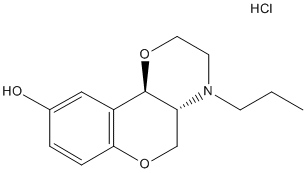
PD 128907 hydrochloride is a compound used in scientific research which acts as a potent and selective agonist for the dopamine D2 and D3 receptors. It is used for studying the role of these receptors in the brain, in roles such as inhibitory autoreceptors that act to limit further dopamine release, as well as release of other neurotransmitters. In animal studies it has been shown to reduce toxicity from cocaine overdose, and may be useful in the development of medical treatments for this condition in humans.
| Cell Experiment | |
|---|---|
| Cell lines | |
| Preparation method | |
| Concentrations | |
| Incubation time | |
| Animal Experiment | |
|---|---|
| Animal models | Mouse |
| Formulation | Water, with sonication |
| Dosages | 3 mg/kg |
| Administration | 3 mg/kg |
| Molecular Weight | 285.77 |
| Formula | C14H19NO3.HCl |
| CAS Number | 112960-16-4 |
| Solubility (25°C) | DMSO 10 mg/mL |
| Storage |
Powder -20°C 3 years ; 4°C 2 years In solvent -80°C 6 months ; -20°C 1 month |
| Species | Mouse | Rat | Rabbit | Guinea pig | Hamster | Dog |
| Weight (kg) | 0.02 | 0.15 | 1.8 | 0.4 | 0.08 | 10 |
| Body Surface Area (m2) | 0.007 | 0.025 | 0.15 | 0.05 | 0.02 | 0.5 |
| Km factor | 3 | 6 | 12 | 8 | 5 | 20 |
| Animal A (mg/kg) = Animal B (mg/kg) multiplied by | Animal B Km |
| Animal A Km |
For example, to modify the dose of Compound A used for a mouse (20 mg/kg) to a dose based on the BSA for a rat, multiply 20 mg/kg by the Km factor for a mouse and then divide by the Km factor for a rat. This calculation results in a rat equivalent dose for Compound A of 10 mg/kg.
| Related Dopamine Receptor Products |
|---|
| SV 156
SV 156 is a potent and selective D2 dopamine receptor antagonist, with a Ki of 2.5 nM for hD2. SV 156 has approximately 40-fold binding selectivity for D2 dopamine receptors compared to the D3 receptor subtype. |
| Cyclo(glycyl-L-leucyl)
Cyclo(glycyl-L-leucyl) (Cyclo(leu-gly)), a neuropeptide, down-regulates dopamine (DA) receptors and attenuates dopaminergic supersensitivity. |
| Onzigolide
Onzigolide (BIM-23A760), a chimeric dopamine-somatostatin compound, shows potent agonist activity at both DA type 2 (D2R) and SST type 2 (SSTR2) receptors. |
| CVL-871
CVL-871 is a partial agonist at dopamine D1/5 receptors and may be used in dementia-related studies. |
| Paliperidone palmitate
Paliperidone palmitate is the ester precursor compound of Paliperidone, a potent dopamine antagonist and 5-HT2A antagonist. Paliperidone is a potent dopamine antagonist and 5-HT2A antagonist. |


Products are for research use only. Not for human use. We do not sell to patients.
© Copyright 2010-2023 AbMole BioScience. All Rights Reserved.
